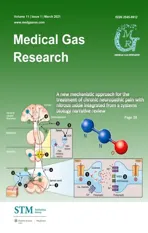Laparoscopic surgeries and carbon dioxide pneumoperitoneum during COVID-19 pandemic:problems and solutions
2021-12-06AbhijitS.Nair,AsielChristopher,KrishnaKishoreKotthapalli等
The advantages of laparoscopic or minimally invasive or robotic-assisted surgeries in abdominal and certain thoracic operations are well understood and are practiced all over the world.The advantages are early recovery,lesser postoperative pain,minimal handling of gut thereby facilitating early bowel recovery.Minimally invasive surgery is one of the advocated modalities whenever possible in the Enhanced Recovery After Surgery pathway for obvious reasons.1With the ongoing COVID-19 pandemic caused by severe acute respiratory syndrome coronavirus 2 (SARSCoV-2) all over the world there are certain pertinent queries raised by societies regarding safety of laparoscopic surgery in suspected or positive COVID-19 patients.
Minimally invasive surgeries involve insertion of ports for having access to abdominal cavity.Thereafter insufflation of abdominal cavity with carbon dioxide is done to create a pneumoperitoneum.This is known to produce surgical plume which is the cause of concern in the current situation and otherwise.To reduce the quantity of surgical plume certain measures are suggested which includes use of smoke evacuation devices,low pneumoperitoneum pressure (i.e.,8-12 mmHg (1 mmHg = 0.133 kPa)) and minimizing the setting of energy device used.The presence of hepatitis B virus,human immunodeficiency virus and human papilloma virus DNA in the surgical plume due to laparoscopy in a positive patient is well known.However,the existing data does not suggest operation theatre (OT) personnel getting infected with this plume.2,3
SARS-CoV-2 is an enveloped,non-segmented,positive sense RNA virus which is included in sarbecovirus,ortho corona virinae subfamily.The diameter is about 65-125 nm with single strands of RNA and crown-like spikes on its outer surface.4The size of particles in the plume ranges from 0.1-25 μm or 100-25,000 nm.5The sizes of hepatitis B virus,human immunodeficiency virus and human papilloma virus DNA are 52-55,120 and approximately 42 nm respectively.Since these viral elements were detected in the surgical plume,the possibility of SARSCoV-2 being released in OT environment is theoretically very high owing to its size.Knowing the unpredictable infectivity and viral shedding of SARS-CoV-2,societies have suggested to postpone elective surgeries in asymptomatic patients and to consider open surgeries in emergency or urgent situations.
Wexner et al.6suggested certain measures that can be used to reduce OT contamination from viral load due to insufflations and laparoscopic surgery.They mentioned use of less trocars for distention (maximum up to 2),desufflation of insufflated gas over closed aerosol waste system that consist of hermetic tubing with two consecutive microparticle filters which is then connected to a mobile high-efficiency particulate air filter.They also recommended covering the patient with a large transparent plastic drape extending till the floor.Society of American Gastrointestinal and Endoscopic Surgeons and The European Association for Endoscopic Surgeons have recommended use of small incisions for port insertions,use of minimal insufflation pressure and careful release of pneumoperitoneum using ultrafiltration or smoke evacuation system for surgical plume.7
Choudhary and Ranjan8devised a simple measure to deal with viral contamination possible during laparoscopic surgeries.Authors suggested the use of two containers containing 5.25-6.15% of sodium hypochlorite solution up to a height of 8-10 cm.An additional tubing is used which is connected to the insufflating port which is used for slow,controlled release of insufflated gas which then is directed to first container followed by a connector which transfers it to second container.The solution used is disposed after the surgery.Authors suggested the use of sodium hypochlorite-soaked gauge piece at trocar insertion sites to address any leak from port site.
The reason for use of hypochlorite solutions is owing to its multimodal activity against micro-organisms like oxidation of sulfhydryl enzymes and amino acids; ring chlorination of amino acids; loss of intracellular contents; decreased uptake of nutrients; inhibition of protein synthesis;decreased oxygen uptake; oxidation of respiratory components; decreased adenosine triphosphate production; breaks in DNA; and depressed DNA synthesis.Moreover,they are cheap,easy to prepare,non-toxic and have rapid onset of action.9
There are certain important advantages of laparoscopic surgeries over the conventional open approach.Faster recovery of patient and early intestinal motility,lesser tissue handling and dissection,decreased perioperative pain,reduced hospital stays,lesser incidence of surgical site infections,reduced postoperative morbidity are certain important advantages that cannot be ignored.For this reason,researchers tried to identify measures which could inherently neutralize or dissolve the flumes in a solvent and thus make the OT pollution negligible.This is to have better patient outcomes by ensuring safety of surgeons,anesthesiologists’ and other health care workers in OT premises.One such technique described is directing the gas used for pneumoperitoneum to a solution containing sodium hypochlorite which appears safe and effective.Further studies could explore whether surgical plumes emerging during laparoscopic surgeries in COVID-19 results in clinically significant viral load,whether the routinely used personnel protective equipment is effective in preventing entry in respiratory tract and whether hypochlorite solution is effectively able to neutralize the viral particles produced in surgical plumes.
Abhijit S.Nair*,Asiel Christopher,Krishna Kishore Kotthapalli,Shyam Prasad Mantha
Department of Anaesthesiology,Basavatarakam Indo-American Cancer Hospital and Research Institute,Hyderabad,India
*Correspondence to:Abhijit S.Nair,abhijitnair95@gmail.com.
orcid:0000-0003-2506-0301 (Abhijit S.Nair)
doi:10.4103/2045-9912.310060
How to cite this article:Nair AS,Christopher A,Kotthapalli KK,Mantha SP.Laparoscopic surgeries and carbon dioxide pneumoperitoneum during COVID-19 pandemic:problems and solutions.Med Gas Res 2021;11(1):46.
Copyright license agreement:The Copyright License Agreement has been signed by all authors before publication.
Plagiarism check:Checked twice by iThenticate.
Peer review:Externally peer reviewed.
Open access statement:This is an open access journal,and articles are distributed under the terms of the Creative Commons Attribution-NonCommercial-ShareAlike 4.0 License,which allows others to remix,tweak,and build upon the work non-commercially,as long as appropriate credit is given and the new creations are licensed under the identical terms.
杂志排行
Medical Gas Research的其它文章
- High-flow hydrogen inhalation might suppresses the immune function of middle-aged participants:a selfcontrolled study
- The effect of dexmedetomidine on decrease of cough,hemodynamic parameters and Ramsay score versus lidocaine during general anesthesia:a randomized clinical trial
- Evaluation of audible leak versus pressure volume loop closure for polyvinyl chloride cuff and polyurethane microcuff in endotracheal tube inflated with air:a prospective randomized study
- The role of nitric oxide in peptic ulcer:a narrative review
- Therapeutic effects of hyperbaric oxygen:integrated review
- A new mechanistic approach for the treatment of chronic neuropathic pain with nitrous oxide integrated from a systems biology narrative review
